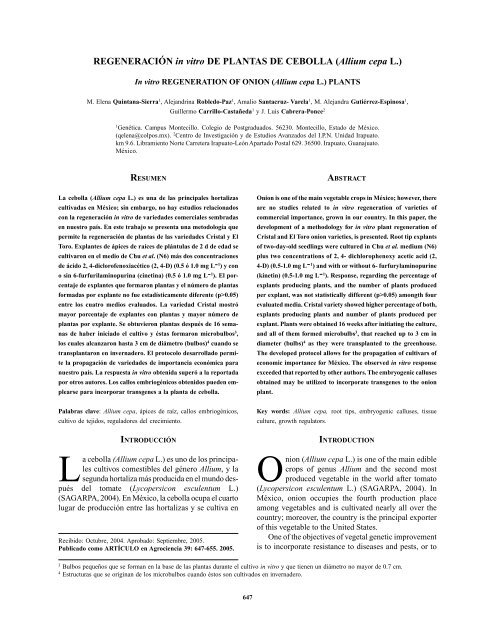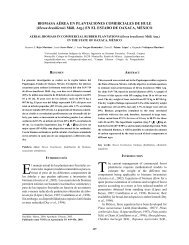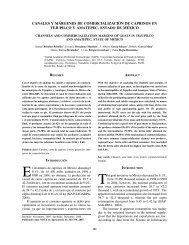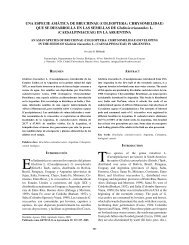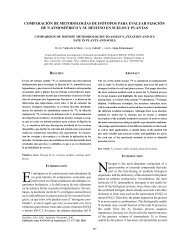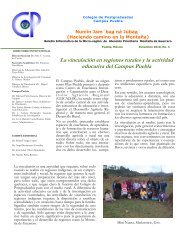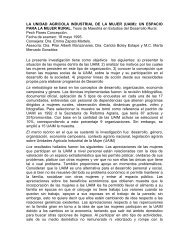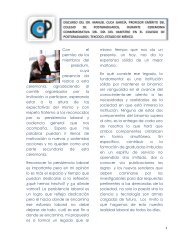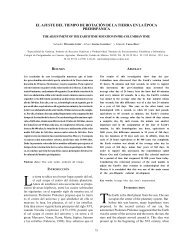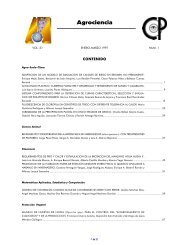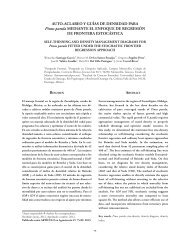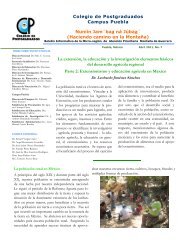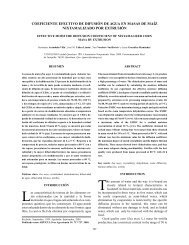04-161 (Regeneración in vitro) - Colegio de Postgraduados
04-161 (Regeneración in vitro) - Colegio de Postgraduados
04-161 (Regeneración in vitro) - Colegio de Postgraduados
You also want an ePaper? Increase the reach of your titles
YUMPU automatically turns print PDFs into web optimized ePapers that Google loves.
REGENERACIÓN <strong>in</strong> <strong>vitro</strong> DE PLANTAS DE CEBOLLA (Allium cepa L.)<br />
In <strong>vitro</strong> REGENERATION OF ONION (Allium cepa L.) PLANTS<br />
M. Elena Qu<strong>in</strong>tana-Sierra1 , Alejandr<strong>in</strong>a Robledo-Paz1 , Amalio Santacruz- Varela1 , M. Alejandra Gutiérrez-Esp<strong>in</strong>osa1 ,<br />
Guillermo Carrillo-Castañeda1 y J. Luis Cabrera-Ponce2 1 Genética. Campus Montecillo. <strong>Colegio</strong> <strong>de</strong> <strong>Postgraduados</strong>. 56230. Montecillo, Estado <strong>de</strong> México.<br />
(qelena@colpos.mx). 2 Centro <strong>de</strong> Investigación y <strong>de</strong> Estudios Avanzados <strong>de</strong>l I.P.N. Unidad Irapuato.<br />
km 9.6. Libramiento Norte Carretera Irapuato-León Apartado Postal 629. 36500. Irapuato, Guanajuato.<br />
México.<br />
RESUMEN<br />
La cebolla (Allium cepa L.) es una <strong>de</strong> las pr<strong>in</strong>cipales hortalizas<br />
cultivadas en México; s<strong>in</strong> embargo, no hay estudios relacionados<br />
con la regeneración <strong>in</strong> <strong>vitro</strong> <strong>de</strong> varieda<strong>de</strong>s comerciales sembradas<br />
en nuestro país. En este trabajo se presenta una metodología que<br />
permite la regeneración <strong>de</strong> plantas <strong>de</strong> las varieda<strong>de</strong>s Cristal y El<br />
Toro. Explantes <strong>de</strong> ápices <strong>de</strong> raíces <strong>de</strong> plántulas <strong>de</strong> 2 d <strong>de</strong> edad se<br />
cultivaron en el medio <strong>de</strong> Chu et al. (N6) más dos concentraciones<br />
<strong>de</strong> ácido 2, 4-diclorofenoxiacético (2, 4-D) (0.5 ó 1.0 mg L−1 ) y con<br />
o s<strong>in</strong> 6-furfurilam<strong>in</strong>opur<strong>in</strong>a (c<strong>in</strong>et<strong>in</strong>a) (0.5 ó 1.0 mg L−1 ). El porcentaje<br />
<strong>de</strong> explantes que formaron plantas y el número <strong>de</strong> plantas<br />
formadas por explante no fue estadísticamente diferente (p>0.05)<br />
entre los cuatro medios evaluados. La variedad Cristal mostró<br />
mayor porcentaje <strong>de</strong> explantes con plantas y mayor número <strong>de</strong><br />
plantas por explante. Se obtuvieron plantas <strong>de</strong>spués <strong>de</strong> 16 semanas<br />
<strong>de</strong> haber <strong>in</strong>iciado el cultivo y éstas formaron microbulbos3 ,<br />
los cuales alcanzaron hasta 3 cm <strong>de</strong> diámetro (bulbos) 4 cuando se<br />
transplantaron en <strong>in</strong>verna<strong>de</strong>ro. El protocolo <strong>de</strong>sarrollado permite<br />
la propagación <strong>de</strong> varieda<strong>de</strong>s <strong>de</strong> importancia económica para<br />
nuestro país. La respuesta <strong>in</strong> <strong>vitro</strong> obtenida superó a la reportada<br />
por otros autores. Los callos embriogénicos obtenidos pue<strong>de</strong>n emplearse<br />
para <strong>in</strong>corporar transgenes a la planta <strong>de</strong> cebolla.<br />
Palabras clave: Allium cepa, ápices <strong>de</strong> raíz, callos embriogénicos,<br />
cultivo <strong>de</strong> tejidos, reguladores <strong>de</strong>l crecimiento.<br />
INTRODUCCIÓN<br />
La cebolla (Allium cepa L.) es uno <strong>de</strong> los pr<strong>in</strong>cipales<br />
cultivos comestibles <strong>de</strong>l género Allium, y la<br />
segunda hortaliza más producida en el mundo <strong>de</strong>spués<br />
<strong>de</strong>l tomate (Lycopersicon esculentum L.)<br />
(SAGARPA, 20<strong>04</strong>). En México, la cebolla ocupa el cuarto<br />
lugar <strong>de</strong> producción entre las hortalizas y se cultiva en<br />
Recibido: Octubre, 20<strong>04</strong>. Aprobado: Septiembre, 2005.<br />
Publicado como ARTÍCULO en Agrociencia 39: 647-655. 2005.<br />
3 Bulbos pequeños que se forman en la base <strong>de</strong> las plantas durante el cultivo <strong>in</strong> <strong>vitro</strong> y que tienen un diámetro no mayor <strong>de</strong> 0.7 cm.<br />
4 Estructuras que se orig<strong>in</strong>an <strong>de</strong> los microbulbos cuando éstos son cultivados en <strong>in</strong>verna<strong>de</strong>ro.<br />
647<br />
ABSTRACT<br />
Onion is one of the ma<strong>in</strong> vegetable crops <strong>in</strong> México; however, there<br />
are no studies related to <strong>in</strong> <strong>vitro</strong> regeneration of varieties of<br />
commercial importance, grown <strong>in</strong> our country. In this paper, the<br />
<strong>de</strong>velopment of a methodology for <strong>in</strong> <strong>vitro</strong> plant regeneration of<br />
Cristal and El Toro onion varieties, is presented. Root tip explants<br />
of two-day-old seedl<strong>in</strong>gs were cultured <strong>in</strong> Chu et al. medium (N6)<br />
plus two concentrations of 2, 4- dichlorophenoxy acetic acid (2,<br />
4-D) (0.5-1.0 mg L−1 ) and with or without 6- furfurylam<strong>in</strong>opur<strong>in</strong>e<br />
(k<strong>in</strong>et<strong>in</strong>) (0.5-1.0 mg L−1 ). Response, regard<strong>in</strong>g the percentage of<br />
explants produc<strong>in</strong>g plants, and the number of plants produced<br />
per explant, was not statistically different (p>0.05) amongth four<br />
evaluated media. Cristal variety showed higher percentage of both,<br />
explants produc<strong>in</strong>g plants and number of plants produced per<br />
explant. Plants were obta<strong>in</strong>ed 16 weeks after <strong>in</strong>itiat<strong>in</strong>g the culture,<br />
and all of them formed microbulbs3 , that reached up to 3 cm <strong>in</strong><br />
diameter (bulbs) 4 as they were transplanted to the greenhouse.<br />
The <strong>de</strong>veloped protocol allows for the propagation of cultivars of<br />
economic importance for México. The observed <strong>in</strong> <strong>vitro</strong> response<br />
excee<strong>de</strong>d that reported by other authors. The embryogenic calluses<br />
obta<strong>in</strong>ed may be utilized to <strong>in</strong>corporate transgenes to the onion<br />
plant.<br />
Key words: Allium cepa, root tips, embryogenic calluses, tissue<br />
culture, growth regulators.<br />
INTRODUCTION<br />
Onion (Allium cepa L.) is one of the ma<strong>in</strong> edible<br />
crops of genus Allium and the second most<br />
produced vegetable <strong>in</strong> the world after tomato<br />
(Lycopersicon esculentum L.) (SAGARPA, 20<strong>04</strong>). In<br />
México, onion occupies the fourth production place<br />
among vegetables and is cultivated nearly all over the<br />
country; moreover, the country is the pr<strong>in</strong>cipal exporter<br />
of this vegetable to the United States.<br />
One of the objectives of vegetal genetic improvement<br />
is to <strong>in</strong>corporate resistance to diseases and pests, or to
AGROCIENCIA, NOVIEMBRE-DICIEMBRE 2005<br />
casi todo el país; y, a<strong>de</strong>más, es el pr<strong>in</strong>cipal exportador <strong>de</strong><br />
esta hortaliza a los EE.UU.<br />
Uno <strong>de</strong> los propósito <strong>de</strong>l mejoramiento genético vegetal<br />
es <strong>in</strong>corporar resistencia a enfermeda<strong>de</strong>s y a plagas,<br />
o a condiciones adversas <strong>de</strong>l ambiente, así como<br />
mejorar sabor, color, forma y tamaño <strong>de</strong> los órganos <strong>de</strong><br />
importancia antropocéntrica. En los programas <strong>de</strong> mejoramiento<br />
genético <strong>de</strong> especies <strong>de</strong> Allium, la hibridación<br />
ha sido la vía clásica que ha permitido la variación<br />
genética en las nuevas varieda<strong>de</strong>s. S<strong>in</strong> embargo, es difícil<br />
superar barreras pre y post fertilización para la hibridación,<br />
como <strong>de</strong>sór<strong>de</strong>nes en el tubo polínico, limitada<br />
recomb<strong>in</strong>ación entre los genomas, y producción <strong>de</strong> una<br />
<strong>in</strong>significante cantidad <strong>de</strong> semillas.<br />
La propagación <strong>in</strong> <strong>vitro</strong> permite la regeneración <strong>de</strong><br />
plantas <strong>de</strong> un genotipo <strong>de</strong>seable en condiciones asépticas<br />
y se utiliza con la <strong>in</strong>tención <strong>de</strong> producir plantas libres <strong>de</strong><br />
enfermeda<strong>de</strong>s, lograr la propagación clonal, la conservación<br />
<strong>de</strong> germoplasma, el rescate <strong>de</strong> híbridos<br />
<strong>in</strong>terespecíficos estériles y la transformación genética<br />
(Eady, 1995).<br />
La regeneración <strong>in</strong> <strong>vitro</strong> <strong>de</strong> cebolla se ha practicado<br />
vía organogénesis (Kamstaityte y Stanys, 2002) y<br />
embriogénesis somática (Saker, 1997; Zheng et al.,<br />
1998; Tanikawa et al., 1998) empleando dist<strong>in</strong>tas partes<br />
<strong>de</strong> la plantas como explante; no obstante, la frecuencia<br />
<strong>de</strong> regeneración ha sido baja (<strong>de</strong> 1 a 6 plantas<br />
por explante). Los protocolos para obtener explantes<br />
implican procedimientos laboriosos (disección <strong>de</strong> embriones<br />
sexuales, <strong>de</strong> ápices <strong>de</strong> vástago o <strong>de</strong> la placa<br />
basal), o sólo contemplan la fase <strong>in</strong> <strong>vitro</strong>. El cultivo <strong>de</strong><br />
ápices <strong>de</strong> raíces pue<strong>de</strong> consi<strong>de</strong>rarse como una opción<br />
en el establecimiento <strong>de</strong> protocolos <strong>de</strong> regeneración<br />
<strong>in</strong> <strong>vitro</strong> <strong>de</strong> cebolla, pues tales órganos pue<strong>de</strong>n obtenerse<br />
fácilmente <strong>de</strong> plántulas y <strong>de</strong> bulbos <strong>de</strong> plantas adultas.<br />
Asimismo, el cultivo <strong>de</strong> ápices ha permitido la regeneración<br />
<strong>de</strong> plantas <strong>de</strong> algunas varieda<strong>de</strong>s <strong>de</strong> cebolla<br />
(Dunstan y Short, 1978) y <strong>de</strong> otras especies <strong>de</strong>l<br />
género Allium, como el ajo (Allium sativum L.) (Myers<br />
y Simon, 1998; Robledo-Paz, et al. 2000). Si bien se<br />
han regenerado <strong>in</strong> <strong>vitro</strong> plantas <strong>de</strong> cebolla <strong>de</strong> varieda<strong>de</strong>s<br />
que se siembran en Japón, Corea <strong>de</strong>l Sur, Nueva<br />
Zelanda, Brasil y Estados Unidos, no se conocen resultados<br />
<strong>de</strong> <strong>in</strong>vestigaciones <strong>de</strong> este tipo en varieda<strong>de</strong>s<br />
que se siembran en México. Dado que la respuesta al<br />
cultivo <strong>in</strong> <strong>vitro</strong> <strong>de</strong>pen<strong>de</strong> <strong>de</strong>l genotipo (Van <strong>de</strong>r Valk et<br />
al., 1992; Saker, 1997; Zheng et al., 1998), es necesario<br />
generar una metodología específica para los<br />
genotipos <strong>de</strong> <strong>in</strong>terés.<br />
Por lo anterior, la presente <strong>in</strong>vestigación tuvo como<br />
objetivo <strong>de</strong>sarrollar un sistema <strong>de</strong> regeneración <strong>in</strong> <strong>vitro</strong><br />
<strong>de</strong> dos varieda<strong>de</strong>s <strong>de</strong> importancia comercial para México,<br />
Cristal y El Toro, mediante el cultivo <strong>de</strong> ápices <strong>de</strong><br />
raíces.<br />
648 VOLUMEN 39, NÚMERO 6<br />
adverse environmental conditions, as well as to improve<br />
flavor, color, shape, and size <strong>in</strong> the organs of<br />
anthropocentric importance. In the programs of genetic<br />
improvement of Allium species, hybridization has been<br />
the classical way permitt<strong>in</strong>g genetic variation <strong>in</strong> the new<br />
varieties. However, it is difficult to overcome pre and<br />
post-fertilization barriers to hybridization, like disor<strong>de</strong>rs<br />
<strong>in</strong> the pollen tube, limited recomb<strong>in</strong>ation among<br />
genomes, and the production of an <strong>in</strong>significant amount<br />
of seeds.<br />
In <strong>vitro</strong> propagation allows for the regeneration of<br />
plants of <strong>de</strong>sirable genotype <strong>in</strong> aseptic conditions and is<br />
utilized with the <strong>in</strong>tention to produce plants free from<br />
diseases, achieve clonal propagation, the conservation<br />
of germ plasma, the rescue of sterile <strong>in</strong>terspecific hybrids,<br />
and genetic transformation (Eady, 1995).<br />
In <strong>vitro</strong> regeneration of onion has been practiced<br />
through organogenesis (Kamstaityte and Stanys, 2002)<br />
and somatic embryogenesis (Saker, 1997; Zheng et al.,<br />
1998; Tanikawa et al., 1998), employ<strong>in</strong>g different plant<br />
parts as explant; nevertheless, regeneration frequency has<br />
been low (1 to 6 plants per explant). The protocols for<br />
obta<strong>in</strong><strong>in</strong>g explants imply laborious procedures (dissection<br />
of sexual embryos, of shoot tips, or of the basal plate), or<br />
only consi<strong>de</strong>r the <strong>in</strong> <strong>vitro</strong> phase. The culture of root tips<br />
may be consi<strong>de</strong>red as an option <strong>in</strong> the establishment of<br />
<strong>in</strong> <strong>vitro</strong> regeneration protocols of onion, s<strong>in</strong>ce such organs<br />
can be easily obta<strong>in</strong>ed from seedl<strong>in</strong>gs as well as from<br />
bulbs of adult plants. Likewise, the culture of tips has<br />
already allowed the plant regeneration of some onion<br />
varieties (Dunstan and Short, 1978) and of other species<br />
of the Allium genus, such as garlic (Allium sativum L.)<br />
(Myers and Simon, 1998; Robledo-Paz et al., 2000).<br />
Although onion plants of varieties sown <strong>in</strong> Japan, South<br />
Korea, New Zealand, Brazil, and the United States have<br />
been regenerated <strong>in</strong> <strong>vitro</strong>, results of this type of research<br />
<strong>in</strong> varieties sown <strong>in</strong> México are not known. As the<br />
response to <strong>in</strong> <strong>vitro</strong> culture <strong>de</strong>pends on the genotype (Van<br />
<strong>de</strong>r Valk et al., 1992; Saker, 1997; Zheng et al., 1998), it<br />
is necessary to generate a specific methodology for the<br />
genotypes of <strong>in</strong>terest.<br />
Regard<strong>in</strong>g the aforesaid, the present research had<br />
the objective to <strong>de</strong>velop a system of <strong>in</strong> <strong>vitro</strong> regeneration<br />
of two varieties of commercial importance for México,<br />
Cristal and El Toro, by means of the culture of root<br />
tips.<br />
MATERIALS AND METHODS<br />
Vegetal material and culture media<br />
Allium cepa L. seeds of the varieties Cristal White Wax and El<br />
Toro (vacuum packed) were utilized, of WESTAR Seed International<br />
Inc. orig<strong>in</strong>ated from El Centro, California, U.S..
MATERIALES Y MÉTODOS<br />
Material vegetal y medios <strong>de</strong> cultivo<br />
Se utilizaron semillas <strong>de</strong> Allium cepa L. <strong>de</strong> las varieda<strong>de</strong>s Cristal<br />
White Wax y El Toro (envasada al vacío) <strong>de</strong> la marca WESTAR Seed<br />
International Inc., proveniente <strong>de</strong> El Centro, California, EE.UU.<br />
La composición <strong>de</strong> los medios <strong>de</strong> cultivo usados en la presente <strong>in</strong>vestigación<br />
se <strong>de</strong>scribe en el Cuadro 1. El pH <strong>de</strong> los medios se ajustó a<br />
5.8±0.1 y éstos se esterilizaron en una autoclave a 1.05 kg cm−2 y 121 °C<br />
durante 15 m<strong>in</strong>. En todos los medios se agregó 0.7% (p/v) <strong>de</strong> agar-agar,<br />
purificado y exento <strong>de</strong> <strong>in</strong>hibidores (Merck, Darmstadt, Alemania).<br />
Inducción <strong>de</strong> callos embriogénicos<br />
Las semillas se colocaron en una solución que contenía 1 g L −1<br />
<strong>de</strong> Fungimyc<strong>in</strong> 100 [18.1% (p/v) estreptomic<strong>in</strong>a y 2.0% (p/v)<br />
oxitetracicl<strong>in</strong>a], y 1 g L−1 <strong>de</strong> Daconil [75% (p/v) Clorotalonil tetracloro<br />
isotalonitrilo] (Química Industrial Agrícola, S. A., México) durante<br />
15 h. Las semillas se transfirieron a una solución <strong>de</strong> 1.8% <strong>de</strong> cloro<br />
activo (v/v) (Cloralex ® , México), a la cual se adicionaron 4 mL L −1 <strong>de</strong><br />
Tween 20 (SIGMA Chemical, USA). En esta solución las semillas<br />
permanecieron 20 m<strong>in</strong>; <strong>de</strong>spués se enjuagaron tres veces con agua<br />
<strong>de</strong>stilada estéril.<br />
Las semillas se colocaron en frascos <strong>de</strong> 100 mL con 25 mL <strong>de</strong>l<br />
medio A, y se <strong>in</strong>cubaron en un cuarto <strong>de</strong> crecimiento a 26±2 °C en<br />
obscuridad. Después <strong>de</strong> 2 d, los ápices <strong>de</strong> las raíces que medían 3 mm<br />
<strong>de</strong> longitud aproximadamente, se cortaron con un bisturí y se colocaron<br />
en cajas Petri con 30 mL <strong>de</strong> cuatro medios <strong>de</strong> <strong>in</strong>ducción (B, C, D<br />
y E), los que se <strong>in</strong>cubaron en oscuridad durante ocho semanas, cambiándolos<br />
a un medio fresco cada cuatro semanas.<br />
Desarrollo <strong>de</strong> los embriones y formación <strong>de</strong> microbulbos<br />
Los explantes con callo se transfirieron a un medio libre <strong>de</strong> reguladores<br />
(F) don<strong>de</strong> permanecieron tres semanas. Se cultivaron en frascos<br />
<strong>de</strong> 100 mL con 25 mL <strong>de</strong> medio G (1.0 mg L−1 BA) durante tres<br />
semanas, se transfirieron al medio H (0.5 mg L−1 BA) por dos semanas<br />
más y las plantas diferenciadas se regresaron al medio F para<br />
cont<strong>in</strong>uar su <strong>de</strong>sarrollo. Los cultivos se colocaron en una cámara <strong>de</strong><br />
ambiente controlado a 26±2 °C con fotoperíodo <strong>de</strong> 16 h luz (lámparas<br />
<strong>de</strong> luz blanca fría fluorescente, con <strong>in</strong>tensidad lumínica <strong>de</strong> 25 µmol<br />
m −2 s −1 ) y 8 h <strong>de</strong> oscuridad.<br />
Las plantas regeneradas se sometieron a un período <strong>de</strong> frío (4 °C)<br />
por dos semanas, condición necesaria para la formación <strong>de</strong><br />
microbulbos, cuya presencia se logró <strong>de</strong>spués <strong>de</strong> un periodo <strong>de</strong><br />
<strong>in</strong>cubación en una cámara <strong>de</strong> crecimiento a 26±2 °C. Las plantas que<br />
formaron microbulbos se transplantaron a <strong>in</strong>verna<strong>de</strong>ro para la fase<br />
f<strong>in</strong>al <strong>de</strong> establecimiento.<br />
Diseño experimental y análisis estadístico<br />
Se empleó un diseño experimental completamente al azar con<br />
tres repeticiones en arreglo factorial, <strong>de</strong> dos factores: varieda<strong>de</strong>s (dos)<br />
REGENERACIÓN <strong>in</strong> <strong>vitro</strong> DE PLANTAS DE CEBOLLA (Allium cepa L.)<br />
The composition of the culture media used <strong>in</strong> the present research<br />
is <strong>de</strong>scribed <strong>in</strong> Table 1. The pH of the media was fitted to 5.8±0.1, and<br />
these were sterilized <strong>in</strong> autoclave at 1.05 kg cm−2 and 121 °C dur<strong>in</strong>g<br />
15 m<strong>in</strong>utes. To all the media, 0.7% (p/v) of purified agar-agar, free<br />
from <strong>in</strong>hibitors, was ad<strong>de</strong>d (Merck, Darmstadt, Germany).<br />
Induction of embryogenic calluses<br />
The seeds were put <strong>in</strong> a solution conta<strong>in</strong><strong>in</strong>g 1 g L−1 of Fungimyc<strong>in</strong><br />
100 [18.1% (p/v) streptomyc<strong>in</strong> and 2.0% (p/v) oxytetracycl<strong>in</strong>e], and<br />
1 g L−1 of Daconyl [75% (p/v) Chlorothallonyl tetrachlori<strong>de</strong><br />
isothallonitrile] (Química Industrial Agrícola, S.A. México) dur<strong>in</strong>g<br />
15 h. The seeds were transferred to a solution of 1.8% of active chlor<strong>in</strong>e<br />
(v/v) (Cloralex ® , México), to which 4 mL L −1 of Tween 20 (Sigma<br />
Chemical, USA) were ad<strong>de</strong>d. In this solution the seeds rema<strong>in</strong>ed for<br />
20 m<strong>in</strong>; then they were r<strong>in</strong>sed three times with sterile distilled water.<br />
The seeds were put <strong>in</strong> 100 mL jars with 25 mL of A culture medium<br />
and <strong>in</strong>cubated <strong>in</strong> a growth room at 26±2 °C <strong>in</strong> the dark. After 2 days,<br />
the root tips, which were approximately 3 mm long, were cut with a<br />
scalpel and placed <strong>in</strong> Petri dishes with 30 mL of four <strong>in</strong>duction media<br />
(B, C, D, and E), which were <strong>in</strong>cubated <strong>in</strong> the dark dur<strong>in</strong>g eight weeks,<br />
chang<strong>in</strong>g them to a fresh medium every four weeks.<br />
Development of embryos and microbulb formation<br />
The explants with callus were transferred to a medium without<br />
regulators (F), where they rema<strong>in</strong>ed dur<strong>in</strong>g three weeks. They were<br />
cultured <strong>in</strong> 100 mL jars with 25 mL of G medium (1.0 mg L−1 BA)<br />
dur<strong>in</strong>g three weeks, then transferred to the H medium (0.5 mg L−1 BA) for another two weeks, and the differentiated plants were returned<br />
Cuadro 1. Composición <strong>de</strong> los medios <strong>de</strong> cultivo utilizados para la<br />
regeneración <strong>de</strong> plantas <strong>de</strong> las varieda<strong>de</strong>s Cristal y El<br />
Toro, a partir <strong>de</strong> explantes <strong>de</strong> ápices <strong>de</strong> raíces obtenidas<br />
<strong>de</strong> plántulas <strong>de</strong> 2 d <strong>de</strong> edad.<br />
Table 1. Composition of the culture media utilized for regeneration<br />
of plants of the varieties Cristal and El Toro, from explants<br />
of root tips obta<strong>in</strong>ed from 2-day-old seedl<strong>in</strong>gs.<br />
Reguladores <strong>de</strong>l<br />
Medio<br />
Sales<br />
Vitam<strong>in</strong>as<br />
Sacarosa<br />
<strong>in</strong>orgánicas (%)<br />
crecimiento<br />
(mg L−1 )<br />
A 50% MS 50% MS 1.5<br />
B N6 MS 2.0 2, 4-D, 1.0<br />
C N6 MS 2.0 2, 4-D, 0.5<br />
D N6 MS 2.0 2, 4-D, 0.5<br />
c<strong>in</strong>et<strong>in</strong>a, 0.5<br />
E N6 MS 2.0 2, 4-D, 1.0<br />
c<strong>in</strong>et<strong>in</strong>a, 1.0<br />
F MS MS 3.0<br />
G MS MS 3.0 BA, 1.0<br />
H MS MS 3.0 BA, 0.5<br />
MS, Murashige y Skoog (1962); N6, Chu et al. (1975); 2, 4-D, ácido<br />
2, 4-diclorofenoxiacético; c<strong>in</strong>et<strong>in</strong>a, 6-furfurilam<strong>in</strong>opur<strong>in</strong>a; BA, N 6 -<br />
bencila<strong>de</strong>n<strong>in</strong>a ❖ MS, Murashige and Skoog (1962); N6, Chu et al.<br />
(1975); 2,4-D, 2,4- dichlorophenoxyacetic acid; k<strong>in</strong>et<strong>in</strong>, 6furfurylam<strong>in</strong>opur<strong>in</strong>e;<br />
BA, N 6 - benzyla<strong>de</strong>n<strong>in</strong>e.<br />
QUINTANA-SIERRA et al.<br />
649
AGROCIENCIA, NOVIEMBRE-DICIEMBRE 2005<br />
y medios <strong>de</strong> cultivo (cuatro), o sea ocho tratamientos. La unidad experimental<br />
fue un grupo <strong>de</strong> 20 explantes. Las variables analizadas<br />
fueron el porcentaje <strong>de</strong> explantes que formaron callos embriogénicos,<br />
el porcentaje <strong>de</strong> explantes que regeneraron plantas a las 12 semanas<br />
<strong>de</strong> haber <strong>in</strong>iciado el cultivo, y el número promedio <strong>de</strong> plantas producidas<br />
por explante a las 16 semanas <strong>de</strong> haber <strong>in</strong>iciado el cultivo. Se<br />
efectuó un análisis <strong>de</strong> varianza con las variables explantes que regeneraron<br />
plantas y número promedio <strong>de</strong> plantas producidas por explante,<br />
dado que la variable porcentaje <strong>de</strong> explantes que formaron callos<br />
embriogénicos registró un valor <strong>de</strong>l 100% para todos los tratamientos.<br />
La variable porcentaje <strong>de</strong> explantes que regeneraron plantas previamente<br />
fue transformada a logaritmo base 10. La comparación <strong>de</strong><br />
medias se efectuó la prueba <strong>de</strong> la diferencia mínima significativa<br />
(DMS, 0.05), y los promedios se presentan en las unida<strong>de</strong>s orig<strong>in</strong>ales.<br />
Los datos se analizaron con SAS (1999).<br />
Transferencia al suelo <strong>de</strong> las plantas con microbulbos<br />
Las plantas que formaron microbulbos <strong>in</strong> <strong>vitro</strong> se extrajeron <strong>de</strong><br />
los frascos y se lavaron con agua corriente con el objeto <strong>de</strong> elim<strong>in</strong>ar<br />
los residuos <strong>de</strong> medio <strong>de</strong> cultivo. Luego, las plantas se sumergieron<br />
en una solución <strong>de</strong> Daconil 1% (p/v) durante 2 m<strong>in</strong> y se transfirieron<br />
a vasos <strong>de</strong> unicel <strong>de</strong> 240 mL conteniendo como sustrato tierra negra<br />
<strong>de</strong> monte, tierra lama y tierra <strong>de</strong> hoja en proporción equivalente<br />
(GARDEN’S, México). Las plantas se cubrieron con una bolsa <strong>de</strong><br />
polietileno transparente <strong>de</strong> 0.5 kg <strong>de</strong> capacidad, don<strong>de</strong> se hizo 15 a<br />
20 perforaciones con una aguja. Los vasos se mantuvieron dos semanas<br />
en una cámara <strong>de</strong> crecimiento a 26±2 °C con 16 h <strong>de</strong> ilum<strong>in</strong>ación.<br />
Después se pasaron a bolsas <strong>de</strong> 10 kg <strong>de</strong> capacidad y se llevaron a un<br />
<strong>in</strong>verna<strong>de</strong>ro don<strong>de</strong> se fertilizaron con la mitad <strong>de</strong> la fórmula 15:30:15<br />
(N, P, K) <strong>de</strong> Miracle-Gro ® (Scotts Co., EE.UU.) por dos semanas, y<br />
<strong>de</strong>spués con la dosis completa cada semana, con el f<strong>in</strong> <strong>de</strong> que los<br />
microbulbos se convirtieran en bulbos.<br />
Los bulbos obtenidos a partir <strong>de</strong> los microbulbos se secaron 30 d<br />
a temperatura ambiente para retirar las hojas y la raíz (cura), se sometieron<br />
a frío (10 °C) por 30 d más, se pasaron a suelo y se llevaron a<br />
una cámara <strong>de</strong> crecimiento a 22±1 °C, don<strong>de</strong> emitieron el vástago y<br />
las raíces.<br />
RESULTADOS Y DISCUSIÓN<br />
Los cuatro medios <strong>de</strong> cultivo (B, C, D y E), permitieron<br />
la formación <strong>de</strong> callos embriogénicos en 100% <strong>de</strong><br />
los ápices <strong>de</strong> raíz cultivados para ambas varieda<strong>de</strong>s. En<br />
el Cuadro 2 se muestran los resultados <strong>de</strong>l análisis <strong>de</strong><br />
varianza. En el porcentaje <strong>de</strong> explantes que formaron<br />
plantas y el número promedio <strong>de</strong> plantas producidas por<br />
explante hubo diferencias altamente significativas entre<br />
varieda<strong>de</strong>s; s<strong>in</strong> embargo, no hubo significancia para<br />
medios <strong>de</strong> cultivo ni para la <strong>in</strong>teracción entre varieda<strong>de</strong>s<br />
y medios <strong>de</strong> cultivo.<br />
En el Cuadro 3 se presentan los promedios <strong>de</strong> ambas<br />
variables para los factores varieda<strong>de</strong>s y medios <strong>de</strong> cultivo.<br />
La variedad Cristal casi duplicó el porcentaje <strong>de</strong><br />
650 VOLUMEN 39, NÚMERO 6<br />
to medium F <strong>in</strong> or<strong>de</strong>r to cont<strong>in</strong>ue their <strong>de</strong>velopment. The cultures<br />
were placed <strong>in</strong> a chamber of controlled environment at 26±2 °C with<br />
photoperiod of 16 h light (lamps of fluorescent cold white light, with<br />
lum<strong>in</strong>ous (light) <strong>in</strong>tensity of 25 mmol m −2 s −1 ) and 8 h of dark.<br />
The regenerated plants were subjected to a cold period (4 °C) for<br />
two weeks, condition necessary for the formation of microbulbs, which<br />
emerged after an <strong>in</strong>cubation period <strong>in</strong> a growth chamber at 26±2 °C.<br />
The plants that formed microbulbs were transplanted <strong>in</strong>to a greenhouse<br />
for the f<strong>in</strong>al phase of establishment.<br />
Experimental <strong>de</strong>sign and statistical analysis<br />
A completely randomized experimental <strong>de</strong>sign was employed,<br />
with three replications <strong>in</strong> factorial arrangement of two factors: varieties<br />
(two) and culture media (four), this is, eight treatments. The<br />
experimental unit was a group of 20 explants. The analyzed variables<br />
were: percentage of explants form<strong>in</strong>g embryogenic calluses, percentage<br />
of explants regenerat<strong>in</strong>g plants at 12 weeks after <strong>in</strong>itiat<strong>in</strong>g the culture,<br />
and the average number of plants produced by explant at 16 weeks<br />
after hav<strong>in</strong>g <strong>in</strong>itiated the culture. An analysis of variance was ma<strong>de</strong><br />
with the explant variables that regenerated plants, and the average<br />
number of plants produced by explant, s<strong>in</strong>ce the variable, percentage<br />
of explants form<strong>in</strong>g embryogenic calluses, recor<strong>de</strong>d a value of 100%<br />
for all the treatments. The variable percentage of explants hav<strong>in</strong>g<br />
regenerated plants previously, was transformed to logarithm base 10.<br />
The means comparison was done with the m<strong>in</strong>imum significant<br />
difference test (DMS, 0.05), and the means are presented <strong>in</strong> the orig<strong>in</strong>al<br />
units. The data were analyzed utiliz<strong>in</strong>g SAS (1999).<br />
Transferr<strong>in</strong>g of the plants with microbulbs to soil<br />
The plants hav<strong>in</strong>g formed microbulbs <strong>in</strong> <strong>vitro</strong> were extracted from<br />
the jars and r<strong>in</strong>sed un<strong>de</strong>r runn<strong>in</strong>g water with the purpose of elim<strong>in</strong>at<strong>in</strong>g<br />
the residues of culture medium. Then the plants were submerged <strong>in</strong> a<br />
1% (p/v) Daconyl solution dur<strong>in</strong>g 2 m<strong>in</strong> to be later transferred to<br />
240 mL Styrofoam mugs conta<strong>in</strong><strong>in</strong>g a substratum of black mounta<strong>in</strong><br />
soil, sludge, and forest soil (humus) <strong>in</strong> equivalent proportion (Gar<strong>de</strong>n’s,<br />
México). The plants were covered with transparent 0.5 kg polyethylene<br />
bags pierced by a needle mak<strong>in</strong>g 15 -20 holes. The mugs were kept <strong>in</strong><br />
a growth chamber at 26±2 °C with 16 h light for two weeks. Afterwards,<br />
they were put <strong>in</strong> 10 kg bags and taken to a greenhouse, where they<br />
were fertilized with half of the 15:30:15 (N, P, K) formula of Miracle-<br />
Gro ® (Scotts Co., U.S.) for two weeks, and later on, every week with<br />
the complete dose, to let the microbulbs grow to bulbs.<br />
The bulbs obta<strong>in</strong>ed from the microbulbs were dried dur<strong>in</strong>g 30 d<br />
at room temperature <strong>in</strong> or<strong>de</strong>r to remove leaves and root (cure), they<br />
were subjected to cold (10 °C) for another 30 d, then transplanted to<br />
soil and taken to a growth chamber at 22±1 ºC, where they emitted<br />
the shoot and the roots.<br />
RESULTS AND DISCUSSION<br />
The four culture media (B,C,D, and E) allowed the<br />
formation of embryogenic calluses <strong>in</strong> 100% of the root
Cuadro 2. Cuadrados medios para las variables porcentaje <strong>de</strong><br />
explantes con plantas y número promedio <strong>de</strong> plantas<br />
por explante.<br />
Table 2. Mean squares for the variables percentage of explants<br />
with plants and average number of plants per explant.<br />
Cuadrados medios<br />
Factor Grados <strong>de</strong><br />
<strong>de</strong> variación libertad Porcentaje <strong>de</strong> Plantas por<br />
explantes con plantas explante<br />
Varieda<strong>de</strong>s (V) 1 3.129 ** 223.26 **<br />
Medios <strong>de</strong> cultivo (M) 3 0.364 ns 7.67 ns<br />
V×M 3 0.230 ns 3.18 ns<br />
Error 16 0.255 16.86<br />
Total 23<br />
CV (%) 14 82<br />
** = altamente significativo ❖ highly significant.<br />
ns = no significativo ❖ non significant.<br />
explantes que regeneraron plantas y produjo casi cuatro<br />
veces más plantas por explante que la variedad El Toro<br />
(Cuadro 3). Esto <strong>in</strong>dica que existen factores genéticos<br />
<strong>in</strong>volucrados en la respuesta a dichas variables, por lo<br />
que la caracterización y ubicación en el genoma representaría<br />
un campo <strong>de</strong> estudio <strong>de</strong> gran <strong>in</strong>terés.<br />
La presencia <strong>de</strong> las sales <strong>de</strong>l medio N6, así como<br />
<strong>de</strong> los fitorreguladores, en los medios <strong>de</strong> cultivo empleados,<br />
fue suficiente para <strong>in</strong>ducir callos<br />
embriogénicos, lo que concuerda con lo reportado para<br />
otras monocotiledóneas como maíz (Zea mays)<br />
(Armstrog y Green, 1985) y ajo (Allium sativum L.)<br />
(Robledo-Paz et al., 2000). Posiblemente el medio<br />
N6 <strong>in</strong>cluye nutrientes factibles <strong>de</strong> ser usados con éxito<br />
en dist<strong>in</strong>tas monocotiledóneas (Robledo-Paz et al.,<br />
2000), lo que sería corroborado con los resultados <strong>de</strong>l<br />
presente trabajo.<br />
La respuesta morfogénica <strong>de</strong> los explantes se <strong>in</strong>ició<br />
con un <strong>in</strong>cremento <strong>de</strong> hasta c<strong>in</strong>co veces su tamaño <strong>de</strong>spués<br />
<strong>de</strong> 30 d <strong>de</strong> cultivo en el medio <strong>de</strong> <strong>in</strong>ducción. La<br />
proliferación celular se <strong>de</strong>tectó en sitios específicos, concentrándose<br />
en las zonas meristemáticas <strong>de</strong>l explante (Figura<br />
1 A). Haque et al. (1997) y Robledo-Paz et al. (2000)<br />
también observaron formación <strong>de</strong> callo sólo en la zona<br />
meristemática <strong>de</strong> la punta <strong>de</strong> la raíz. Los callos producidos<br />
<strong>de</strong>spués <strong>de</strong> ocho semanas fueron <strong>de</strong> dos tipos, uno<br />
<strong>de</strong> color amarillo claro, compacto y translúcido y otro<br />
amarillo <strong>in</strong>tenso, opaco, fácilmente disgregable (friable),<br />
o sea, con características similares a los reportados por<br />
Van <strong>de</strong>r Valk et al. (1992) y Zheng et al. (1998) en Allium<br />
cepa. A<strong>de</strong>más, los callos <strong>de</strong> la variedad Cristal fueron<br />
más friables y <strong>de</strong> color amarillo más <strong>in</strong>tenso que los <strong>de</strong><br />
la variedad El Toro; es <strong>de</strong>cir, hubo diferencias entre<br />
genotipos lo que concuerda con lo mencionado por<br />
Novák et al. (1986), quienes encontraron pigmentación<br />
diferencial entre genotipos.<br />
REGENERACIÓN <strong>in</strong> <strong>vitro</strong> DE PLANTAS DE CEBOLLA (Allium cepa L.)<br />
Cuadro 3. Promedios <strong>de</strong> explantes con plantas y plantas formadas<br />
por explante <strong>in</strong>ducidos en varieda<strong>de</strong>s <strong>de</strong> cebolla<br />
crecidos en cuatro medios <strong>de</strong> cultivo.<br />
Table 3. Means of explants with plants and plants formed by<br />
explant <strong>in</strong>duced to onion varieties grown <strong>in</strong> four culture<br />
media.<br />
Medio<br />
<strong>de</strong> cultivo<br />
Varieda<strong>de</strong>s<br />
Cristal El Toro<br />
Explantes con plantas (%)<br />
tips cultured for both varieties. In Table 2, the results of<br />
the analysis of variance are shown. There were highly<br />
significant differences between varieties with respect to<br />
the percentage of explants <strong>de</strong>velop<strong>in</strong>g plants and the<br />
average number of plants produced by explants; however,<br />
there was no significant difference for culture media,<br />
neither for <strong>in</strong>teraction among varieties and culture media.<br />
The means of both variables for the factors varieties<br />
and culture media are shown <strong>in</strong> Table 3. Cristal variety<br />
nearly doubled the percentage of explants which<br />
regenerated plants, and produced almost four times more<br />
plants per explant than El Toro variety (Table 3). This<br />
<strong>in</strong>dicates that there are genetic factors, <strong>in</strong>volved <strong>in</strong> the<br />
response to said variables, and that is why characterization<br />
and location <strong>in</strong> the genome would be a field of study of<br />
great <strong>in</strong>terest.<br />
The presence of salts of the N6 medium as well as of<br />
the phytoregulators employed <strong>in</strong> the culture media, was<br />
sufficient to <strong>in</strong>duce embryogenic calluses, which agrees<br />
with the reports on other monocotyledons, such as corn<br />
(Zea mays) (Armstrong and Green, 1985) and garlic<br />
(Allium sativum L.) (Robledo-Paz et al., 2000). Possibly,<br />
the N6 medium <strong>in</strong>clu<strong>de</strong>s nutrients, feasible of be<strong>in</strong>g used<br />
successfully <strong>in</strong> different monocotyledons (Robledo-Paz<br />
QUINTANA-SIERRA et al.<br />
Promedio<br />
B 73.3 40.0 56.7 a<br />
C 66.7 35.0 50.9 a<br />
D 50.0 38.3 44.2 a<br />
E 55.0 21.7 38.4 a<br />
Promedio 61.3 a 33.8 b 47.6<br />
Plantas por explante<br />
B 10.6 2.7 6.6 a<br />
C 8.0 1.9 5.0 a<br />
D 6.5 1.8 4.2 a<br />
E 7.9 1.3 4.6 a<br />
Promedio 8.3 a 1.9 b 5.1<br />
Promedios entre varieda<strong>de</strong>s o entre medios <strong>de</strong> cultivo con diferente<br />
letra son estadísticamente diferentes (p≤0.05). B, (N6+2, 4-D, 1.0<br />
mg L −1 ); C, (N6+2, 4-D, 0.5 mg L −1 ); D, (N6+2, 4-D, 0.5 mg L −1 y<br />
c<strong>in</strong>et<strong>in</strong>a 0.5 mg L −1 ), y E (N6+2, 4-D, 1.0 mg L −1 y c<strong>in</strong>et<strong>in</strong>a 1.0 mg<br />
L −1 ) ❖ Means among varieties or among culture media with different<br />
letter are statistically different (p≤0.05) B, (N6+2, 4-D, 1.0 mg L −1 );<br />
C, (N6+2, 4-D, 0.5 mg L −1 ); D,(N6+2, 4-D, 0.5 mg L −1 and k<strong>in</strong>et<strong>in</strong><br />
0.5 mg L −1 ), and E (N6+2, 4-D, 1.0 mg L −1 and k<strong>in</strong>et<strong>in</strong> 1.0 mg L −1 ).<br />
651
AGROCIENCIA, NOVIEMBRE-DICIEMBRE 2005<br />
10 mm<br />
Figura 1. <strong>Regeneración</strong> <strong>in</strong> <strong>vitro</strong> <strong>de</strong> plantas <strong>de</strong> cebolla (Allium cepa L.). A: ápices <strong>de</strong> raíz <strong>de</strong>spués <strong>de</strong> cuatro semanas en el medio <strong>de</strong><br />
<strong>in</strong>ducción B. B: callo embriogénico <strong>de</strong>spués <strong>de</strong> ocho semanas <strong>de</strong> cultivo en el medio B. C: plantas regeneradas <strong>de</strong>spués <strong>de</strong> 16<br />
semanas <strong>de</strong> <strong>in</strong>iciar el cultivo. D: formación <strong>de</strong> microbulbos en las plantas regeneradas <strong>in</strong> <strong>vitro</strong>. E: bulbo <strong>de</strong>spués <strong>de</strong> 12 semanas<br />
<strong>de</strong> estar creciendo en <strong>in</strong>verna<strong>de</strong>ro. F: plantas obtenidas a partir <strong>de</strong> bulbos obtenidos en el <strong>in</strong>verna<strong>de</strong>ro.<br />
Figure 1. In <strong>vitro</strong> regeneration of onion plants (Allium cepa L.), A: root tips after four weeks <strong>in</strong> <strong>in</strong>duction medium B. B: embryogenic<br />
callus after eight weeks of culture <strong>in</strong> medium B. C: regenerated plants after 16 weeks of <strong>in</strong>itiat<strong>in</strong>g the culture. D: microbulb<br />
formation <strong>in</strong> plants regenerated <strong>in</strong> <strong>vitro</strong>. E: bulb after 12 weeks grow<strong>in</strong>g <strong>in</strong> greenhouse. F: plants obta<strong>in</strong>ed from bulbs produced<br />
<strong>in</strong> greenhouse.<br />
Se obtuvieron callos embriogénicos (Figura 1B) tanto<br />
en presencia únicamente <strong>de</strong> 2, 4-D y en comb<strong>in</strong>ación<br />
con c<strong>in</strong>et<strong>in</strong>a. S<strong>in</strong> embargo, la formación <strong>de</strong> plantas a partir<br />
<strong>de</strong> estos callos fue numéricamente menor cuando los<br />
callos embriogénicos fueron <strong>in</strong>ducidos en los medios que<br />
contenían 2, 4-D y c<strong>in</strong>et<strong>in</strong>a (Cuadro 3). Estos resultados<br />
contrastan con lo reportado por Robledo-Paz et al. (2000)<br />
y Van <strong>de</strong>r Valk et al. (1992) para tejidos <strong>de</strong> ajo y cebolla,<br />
pero concuerdan con lo observado en cultivos<br />
embriogénicos <strong>de</strong> cacahuate (Arachis hypogaea L.)<br />
(Baker y Wetzste<strong>in</strong>, 1994) y chile (Capsicum annuum<br />
L.) (Ste<strong>in</strong>itz et al., 2003). La poca <strong>in</strong>fluencia <strong>de</strong> la c<strong>in</strong>et<strong>in</strong>a<br />
en la regeneración <strong>de</strong> plantas <strong>de</strong> cebolla podría <strong>de</strong>berse a<br />
que los niveles usados <strong>de</strong> este fitorregulador fueron mayores<br />
o menores que las concentraciones requeridas para<br />
652 VOLUMEN 39, NÚMERO 6<br />
A B C<br />
1 mm<br />
E<br />
1 mm<br />
10 cm<br />
et al., 2000),which would be corroborated by the results<br />
of the present study.<br />
The morphogenic response of the explants began with<br />
an <strong>in</strong>crement of up to five times their size after 30 d of<br />
culture <strong>in</strong> the medium of <strong>in</strong>duction. Cellular proliferation<br />
was <strong>de</strong>tected at specific sites, be<strong>in</strong>g concentrated <strong>in</strong><br />
meristematic zones of the explant (Figure 1A). Haque et<br />
al. (1997) and Robledo-Paz et al. (2000) also observed<br />
callus formation only <strong>in</strong> the meristematic zone of the root<br />
tip. The calluses, produced after eight weeks, were of<br />
two types, one, light yellow, compact, and translucent,<br />
and the other, of <strong>in</strong>tense yellow color, opaque, easily be<strong>in</strong>g<br />
dis<strong>in</strong>tegrated (friable); <strong>in</strong> other words, with characteristics<br />
similar to those reported by Van <strong>de</strong>r Valk et al. (1992)<br />
and Zheng et al. (1998) for Allium cepa. Furthermore,<br />
F<br />
10 mm<br />
5 mm<br />
D
establecer el nivel hormonal endógeno a<strong>de</strong>cuado que <strong>in</strong>fluyera<br />
positivamente en las células <strong>de</strong> los ápices <strong>de</strong> raíz<br />
en su capacidad para regenerar plantas. Lo anterior obe<strong>de</strong>ce<br />
a que la respuesta <strong>de</strong>l explante está en función <strong>de</strong><br />
los niveles hormonales endógenos <strong>de</strong> éste durante el cultivo<br />
<strong>in</strong> <strong>vitro</strong> (Fehér et al., 2003). La función <strong>in</strong>ductora<br />
<strong>de</strong>l 2, 4-D en la embriogénesis somática ha sido observado<br />
por otros autores (Van <strong>de</strong>r Valk et al., 1992; Zeng<br />
et al., 1998; Myers y Simon, 1998), y se confirma con<br />
los resultados <strong>de</strong>l presente trabajo. Se ha <strong>de</strong>mostrado que<br />
el 2, 4-D estimula la síntesis <strong>de</strong> otras aux<strong>in</strong>as como el<br />
ácido <strong>in</strong>dol acético (AIA) en células <strong>de</strong> zanahoria (Daucus<br />
carota L.) (Michalczuk et al., 1992). Asimismo, se ha<br />
propuesto que el 2, 4-D podría actuar no sólo como una<br />
aux<strong>in</strong>a, s<strong>in</strong>o también como un herbicida, el cual <strong>in</strong>duce<br />
respuestas a estrés (Grossmann, 2000). Lo anterior se<br />
fundamenta en el hecho <strong>de</strong> que la presencia <strong>de</strong>l 2, 4-D<br />
en el medio <strong>de</strong> cultivo <strong>in</strong>duce la expresión <strong>de</strong> varios genes<br />
relacionados con el estrés en células <strong>de</strong> alfalfa (Medicago<br />
sativa) (Györgyey et al., 1991; Davletova et al., 2001).<br />
Tres semanas <strong>de</strong>spués <strong>de</strong> que los callos se transfirieron<br />
al medio F (libre <strong>de</strong> reguladores <strong>de</strong>l crecimiento)<br />
triplicaron su tamaño, advirtiéndose la presencia <strong>de</strong> algunos<br />
embriones <strong>de</strong> los cuales emergían el vástago y la<br />
raíz para convertirse en plantas. El estudio anatómico,<br />
que permitirá corroborar la ontogenia y bipolaridad <strong>de</strong><br />
los embriones, está en proceso. El mantener las plantas<br />
en los medios G (1 mg L −1 <strong>de</strong> BA), H (0.5 mg L −1 <strong>de</strong><br />
BA) y F promovió su crecimiento hasta un tamaño en el<br />
cual pudieron someterse a un tratamiento que <strong>in</strong>dujera la<br />
formación <strong>de</strong> microbulbos.<br />
Las plantas regeneradas <strong>in</strong> <strong>vitro</strong> que se mantuvieron<br />
a 4 °C por 15 d, formaron microbulbos en su base dos<br />
semanas <strong>de</strong>spués <strong>de</strong> retiradas <strong>de</strong> esta condición. Los<br />
microbulbos cont<strong>in</strong>uaron su crecimiento hasta convertirse<br />
en bulbos que alcanzaron un tamaño <strong>de</strong> 3 cm <strong>de</strong><br />
diámetro <strong>de</strong>spués <strong>de</strong> 32 semanas <strong>de</strong> haber <strong>in</strong>iciado el<br />
cultivo <strong>de</strong> ápices (Figura 1E), y a las 52 semanas <strong>de</strong> tal<br />
<strong>in</strong>icio, las plantas <strong>de</strong> cebolla obtenidas <strong>de</strong> estos bulbos<br />
aún cont<strong>in</strong>uaban su crecimiento en el <strong>in</strong>verna<strong>de</strong>ro (Figura<br />
1F).<br />
Aunque Dunstan y Short (1978) emplearon ápices<br />
<strong>de</strong> raíces para regenerar plantas <strong>de</strong> algunas varieda<strong>de</strong>s<br />
<strong>de</strong> cebolla (Giant Zittau e Inai Early Yellow), era necesario<br />
establecer las condiciones <strong>de</strong> cultivo <strong>in</strong> <strong>vitro</strong> que <strong>in</strong>dujeran<br />
la mejor respuesta en varieda<strong>de</strong>s <strong>de</strong> <strong>in</strong>terés para<br />
México como Cristal y El Toro. Asimismo, aunque se ha<br />
reportado la regeneración <strong>de</strong> plantas <strong>de</strong> cebolla a partir<br />
<strong>de</strong> otros explantes (Van <strong>de</strong>r Valk et al., 1992; Mohamed-<br />
Yasseen y Splittstoesser, 1992; Saker 1997; Zheng et al.,<br />
1998), la mayoría <strong>de</strong> estos protocolos sólo contemplan la<br />
fase <strong>in</strong> <strong>vitro</strong>, por lo que no proporcionan <strong>in</strong>formación acerca<br />
<strong>de</strong> el tiempo requerido para el establecimiento <strong>de</strong> las plantas<br />
en suelo, ni se ha dado seguimiento al <strong>de</strong>sarrollo <strong>de</strong> la<br />
REGENERACIÓN <strong>in</strong> <strong>vitro</strong> DE PLANTAS DE CEBOLLA (Allium cepa L.)<br />
calluses of the Cristal variety were more friable and more<br />
<strong>in</strong>tensely yellow than those of El Toro variety, this means,<br />
there were differences among genotypes, which agrees<br />
with Novák et al. (1986), who found differential<br />
pigmentation among genotypes.<br />
Embryogenic calluses (Figure 1B) were <strong>de</strong>veloped<br />
<strong>in</strong> presence of 2,4-D alone, as well as <strong>in</strong> comb<strong>in</strong>ation<br />
with k<strong>in</strong>et<strong>in</strong>. However, plants produced by these calluses<br />
were less numerous when embryogenic calluses were<br />
<strong>in</strong>duced to media conta<strong>in</strong><strong>in</strong>g 2, 4-D and k<strong>in</strong>et<strong>in</strong> (Table<br />
3). These results contrast with those reported by Robledo-<br />
Paz et al. (2000) and Van <strong>de</strong>r Valk et al.(1992) for garlic<br />
and onion tissues, but agree with what was observed <strong>in</strong><br />
embryogenic cultures of peanut (Arachis hypogaea L.)<br />
(Baker and Wetzste<strong>in</strong>, 1994) and pepper (Capsicum<br />
annuum L.) (Ste<strong>in</strong>itz et al., 2003). The <strong>in</strong>significant<br />
<strong>in</strong>fluence of k<strong>in</strong>et<strong>in</strong> on onion plant regeneration might<br />
be due to the fact that the utilized levels of this<br />
phytoregulator were higher or lower than the<br />
concentrations, required to establish an a<strong>de</strong>quate<br />
endogenous hormone level, that could have a positive<br />
effect on the cells of the root tips <strong>in</strong> their capacity of<br />
regenerat<strong>in</strong>g plants. The previous is due to the fact that<br />
the response of the explant is a function of its endogenous<br />
hormone levels dur<strong>in</strong>g <strong>in</strong> <strong>vitro</strong> culture (Fehér et al., 2003).<br />
The <strong>in</strong>ductive function of 2, 4-D <strong>in</strong> somatic<br />
embryogenesis has been observed by other authors (Van<br />
<strong>de</strong>r Valk et al., 1992; Zheng et al., 1998; Myers and<br />
Simon, 1998) and is confirmed by the results of the<br />
present paper. It has been <strong>de</strong>monstrated that 2, 4-D<br />
stimulates the synthesis of other aux<strong>in</strong>s, like <strong>in</strong>doleacetic<br />
acid (AIA) <strong>in</strong> carrot (Daucus carota L.) cells (Michalczuk<br />
et al., 1992). Likewise, it has been suggested that 2, 4-D<br />
might act not only as an aux<strong>in</strong>, but also as herbici<strong>de</strong>,<br />
which generates responses to stress (Grossmann, 2000).<br />
The aforesaid is based on the fact that 2, 4-D presence <strong>in</strong><br />
the culture medium orig<strong>in</strong>ates the expression of several<br />
genes related to stress <strong>in</strong> cells of alfalfa (Medicago sativa)<br />
(Györgyey et al., 1991; Davletova et al., 2001).<br />
Three weeks after the calluses had been transferred<br />
to medium F (without growth regulators), they tripled<br />
their size, and the presence of some embryos was<br />
perceived, whose shoot and root emerged to become<br />
plants. The anatomic study, which will permit to<br />
corroborate ontogeny and bipolarity of the embryos, is<br />
be<strong>in</strong>g conducted. Keep<strong>in</strong>g the plants <strong>in</strong> media G (1mg<br />
L −1 of BA), H (0.5 mg L −1 of BA), and F, promoted their<br />
growth until reach<strong>in</strong>g a size where they could be subjected<br />
to a treatment, which would <strong>in</strong>duce microbulb formation.<br />
Plants regenerated <strong>in</strong> <strong>vitro</strong>, be<strong>in</strong>g ma<strong>in</strong>ta<strong>in</strong>ed at 4 °C<br />
for 15 days, formed microbulbs at their base, two weeks<br />
after be<strong>in</strong>g removed from this condition. The microbulbs<br />
cont<strong>in</strong>ued their growth until they turned to bulbs, reach<strong>in</strong>g<br />
a diameter of 3 cm after 32 weeks of <strong>in</strong>itiat<strong>in</strong>g the culture<br />
QUINTANA-SIERRA et al.<br />
653
AGROCIENCIA, NOVIEMBRE-DICIEMBRE 2005<br />
planta hasta la formación <strong>de</strong>l bulbo. Estos aspectos merecen<br />
ser consi<strong>de</strong>rados, puesto que la respuesta evaluada<br />
<strong>in</strong> <strong>vitro</strong> no garantiza el éxito <strong>de</strong> las plantas cuando crecen<br />
en <strong>in</strong>verna<strong>de</strong>ro o campo.<br />
Las ventajas que ofrece el presente protocolo <strong>de</strong> regeneración<br />
<strong>in</strong> <strong>vitro</strong>, no reportado con anterioridad, son:<br />
1) permite la propagación <strong>de</strong> varieda<strong>de</strong>s cebolla <strong>de</strong> importancia<br />
económica para México; 2) la respuesta <strong>in</strong> <strong>vitro</strong><br />
supera la reportada por Dunstan y Short (1978), quienes<br />
al usar ápices <strong>de</strong> raíces como explante sólo regeneraron<br />
un promedio <strong>de</strong> 4.5 brotes adventicios por ápice, mientras<br />
que en el presente protocolo se obtuvieron ocho plantas<br />
promedio por explante, y algunos explantes lograron<br />
formar hasta 19 plantas; 3) las plantas regeneradas pue<strong>de</strong>n<br />
formar microbulbos a 20 semanas <strong>de</strong> <strong>in</strong>iciado el cultivo<br />
<strong>de</strong> los ápices y los microbulbos pue<strong>de</strong>n usarse como<br />
propágulos o semilla sana <strong>de</strong> genotipos seleccionados,<br />
que podría complementar la propagación a través <strong>de</strong> semilla<br />
botánica; 4) las raíces emitidas <strong>de</strong> cada microbulbo<br />
producido <strong>in</strong> <strong>vitro</strong> también pue<strong>de</strong>n emplearse como<br />
explantes para producir nuevas plantas, lo que potencia<br />
la eficiencia <strong>de</strong> regeneración <strong>de</strong> este protocolo; 5) los<br />
callos morfogenéticos <strong>in</strong>ducidos con las condiciones <strong>de</strong><br />
cultivo <strong>de</strong>sarrolladas en el presente estudio, muestran una<br />
alta velocidad <strong>de</strong> crecimiento cuando se cultivan a <strong>in</strong>tervalos<br />
regulares (15 d), lo que <strong>in</strong>dica que las células <strong>de</strong><br />
estos callos tienen la capacidad para <strong>in</strong>tegrar y expresar<br />
genes <strong>in</strong>troducidos por <strong>in</strong>geniería genética a la cebolla,<br />
consi<strong>de</strong>rada una especie difícil <strong>de</strong> manipular por esta tecnología<br />
(Eady, 1995). Si la fuente <strong>de</strong> explantes (ápices<br />
<strong>de</strong> raíces) no fuera una plántula s<strong>in</strong>o un bulbo (que pue<strong>de</strong><br />
formar cerca <strong>de</strong> 70 raíces), sería posible regenerar hasta<br />
581 plantas por bulbo en cuatro meses.<br />
CONCLUSIONES<br />
Se estableció un protocolo para regenerar <strong>in</strong> <strong>vitro</strong><br />
plantas <strong>de</strong> las varieda<strong>de</strong>s <strong>de</strong> cebolla Cristal y El Toro.<br />
Los ápices <strong>de</strong> raíces obtenidos <strong>de</strong> plántulas fueron a<strong>de</strong>cuados<br />
como explantes. El sistema establecido permite<br />
obtener plantas en cuatro meses las cuales pue<strong>de</strong>n <strong>de</strong>sarrollarse<br />
hasta la formación <strong>de</strong> bulbos. La capacidad <strong>de</strong><br />
regeneración fue mayor en Cristal que en El Toro.<br />
LITERATURA CITADA<br />
Armstrog, C. L., and C. E. Green. 1985. Establishment and<br />
ma<strong>in</strong>tenance of friable, embryogenic maize callus and the<br />
<strong>in</strong>volvement of L-prol<strong>in</strong>e. Planta 164: 209-214.<br />
Baker, C. M., and H. Y. Wetzste<strong>in</strong>. 1994. Influence of aux<strong>in</strong> type and<br />
concentration on peanut somatic embryogenesis. Plant Cell Tissue<br />
and Organ Culture 36: 361-368.<br />
Chu, C. C., C. C. Wang, S. C. Sun, C. Hsu, K. C. Y<strong>in</strong>, C. Y. Chu, and<br />
F. Y. Bi. 1975. Establishment of an efficient medium for anther<br />
culture of rice through comparative experiments on the nitrogen<br />
sources. Science S<strong>in</strong>ica 18: 659-688.<br />
654 VOLUMEN 39, NÚMERO 6<br />
of tips (Figure 1E), and 52 weeks after this start, the onion<br />
plants obta<strong>in</strong>ed from these bulbs still cont<strong>in</strong>ued grow<strong>in</strong>g<br />
<strong>in</strong> the greenhouse (Figure 1F).<br />
Though Dunstan and Short (1978) utilized root tips<br />
to regenerate plants of some onion varieties (Giant Zittau<br />
and Inai Early Yellow), it was necessary to establish the<br />
conditions of <strong>in</strong> <strong>vitro</strong> culture to create the best response<br />
<strong>in</strong> varieties of <strong>in</strong>terest for México, such as Cristal and El<br />
Toro. Likewise, although the regeneration of onion plants<br />
from other explants has been reported (Van <strong>de</strong>r Valk et<br />
al., 1992; Mohamed-Yasseen and Splittstoesser, 1992;<br />
Saker, 1997; Zheng et al., 1998), most of these protocols<br />
only consi<strong>de</strong>red the <strong>in</strong> <strong>vitro</strong> phase; therefore, they do not<br />
provi<strong>de</strong> <strong>in</strong>formation about the time required for the<br />
establishment of the plants <strong>in</strong> soil, and the plant<br />
<strong>de</strong>velopment until bulb formation has not been monitored<br />
either. These aspects <strong>de</strong>serve to be consi<strong>de</strong>red, s<strong>in</strong>ce the<br />
response evaluated <strong>in</strong> <strong>vitro</strong> does not guarantee the success<br />
of the plants when they grow <strong>in</strong> greenhouse or <strong>in</strong> the<br />
field.<br />
The present protocol of <strong>in</strong> <strong>vitro</strong> regeneration, not<br />
reported previously, offers the follow<strong>in</strong>g advantages: 1)<br />
is permits the propagation of onion varieties economically<br />
important for México; 2) the <strong>in</strong> <strong>vitro</strong> response surpasses<br />
the ones reported by Dunstan and Short (1978), who<br />
−us<strong>in</strong>g root tips as explant− only regenerated an average<br />
of 4.5 adventitious shoots per tip, whereas <strong>in</strong> the present<br />
protocol, eight plants per explant on average were<br />
obta<strong>in</strong>ed, and some explants were able to form up to 19<br />
plants; 3) the regenerated plants may produce microbulbs<br />
at 20 weeks of hav<strong>in</strong>g <strong>in</strong>itiated the culture of tips, and<br />
the microbulbs can be used as propagules or healthy seed<br />
of selected genotypes, which could complement<br />
propagation through botanical seed; 4) the roots emitted<br />
by each microbulb produced <strong>in</strong> <strong>vitro</strong>, also can be utilized<br />
as explants for the production of new plants, which<br />
re<strong>in</strong>forces the regeneration efficiency of this protocol; 5)<br />
the morphogenetic calluses, <strong>in</strong>duced un<strong>de</strong>r the culture<br />
conditions <strong>de</strong>veloped <strong>in</strong> the present study, present high<br />
growth rate, when they are cultured at regular <strong>in</strong>tervals<br />
(15 d), which <strong>in</strong>dicates that the cells of these calluses<br />
have the capacity to <strong>in</strong>tegrate and express genes<br />
<strong>in</strong>troduced by genetic eng<strong>in</strong>eer<strong>in</strong>g to onions, consi<strong>de</strong>red<br />
a species difficult to manipulate by this technology (Eady,<br />
1995). If the orig<strong>in</strong> of explants (root tips) were not a<br />
seedl<strong>in</strong>g, but a bulb, (be<strong>in</strong>g able to produce approximately<br />
70 roots) it would be possible to regenerate up to 581<br />
plants per bulb, with<strong>in</strong> four months.<br />
CONCLUSIONS<br />
A protocol to regenerate <strong>in</strong> <strong>vitro</strong> plants of the onion<br />
varieties Cristal and El Toro was established. The root<br />
tips obta<strong>in</strong>ed from seedl<strong>in</strong>gs were a<strong>de</strong>quate as explants.
Davletova, S., T. Meszaros, P. Miskolczi, A. Oberschall, K. Torok, D.<br />
Dudits, and M. Deak. 2001. Aux<strong>in</strong> and heat shock activation of a<br />
novel member of the calmodul<strong>in</strong> like doma<strong>in</strong> prote<strong>in</strong> k<strong>in</strong>ase gene<br />
family <strong>in</strong> cultured alfalfa cells. J. Exp. Bot. 52: 215-221.<br />
Dunstan, D. I., and K. C. Short. 1978. Shoot production from onion<br />
callus tissue cultures. Scientia Horticulturae 9: 99-110.<br />
Eady, C. C. 1995. Towards the transformation of onion (Allium cepa<br />
L.). N. Z. J. Crop and Hort. Sci. 23: 239-250.<br />
Fehér, A., T. P. Pasternak, and D. Dusits. 2003. Transition of somatic<br />
plant cells to an embryogenic state. Plant Cell Tissue and Organ<br />
Culture 74: 201-228<br />
Grossmann, K. 2000. Mo<strong>de</strong> of action of aux<strong>in</strong>ic herbici<strong>de</strong>s: a new<br />
end<strong>in</strong>g to a long, drawn out story. Trends Plant Sci. 5: 506-508.<br />
Györgyey, J., A. Gartner, K. Nemeth, Z. Magyar, H. Hirt, E. Heberle-<br />
Bors, and D. Dudits. 1991. Alfalfa heat shock genes are<br />
differentially expressed dur<strong>in</strong>g somatic embryogenesis. Plant<br />
Molecular Biol. 16: 999-1007.<br />
Haque, M. S., T. Wada, and K. Hattori. 1997. High frequency shoot<br />
regeneration and plantlet formation root tip of garlic. Plant Cell<br />
Tissue and Organ Culture 50: 83-89.<br />
Kamstaityte, D., and V. Stanys. 2002. Pathways of onion regeneration<br />
via flower and ovary culture. Zemdirbyste, Mokslo Darbai 78:<br />
245-250.<br />
Michalczuk, L., T. J. Cooke, and J. D. Cohen. 1992. Aux<strong>in</strong> levels at<br />
different stages of carrot somatic embryogenesis. Phytochemistry<br />
31: 1097-1103.<br />
Mohamed-Yasseen, Y., and W. E. Splittstoesser. 1992. Regeneration<br />
of onion (Allium cepa L.) bulbs <strong>in</strong> <strong>vitro</strong>. Plant Growth Regulator<br />
Soc. Am. Q. 20: 76-82.<br />
Murashige, T., and F. Skoog. 1962. A revised medium for rapid growth<br />
and bioassays with tabacco tissue cultures. Physiol. Plant 15: 473-<br />
497.<br />
Myers, J. M., and P. W. Simon. 1998. Cont<strong>in</strong>uous callus production<br />
and regeneration of garlic (Allium sativum L.) us<strong>in</strong>g root segments<br />
from shoot tip-<strong>de</strong>rived plantlets. Plant Cell Rep. 17: 726-730.<br />
Novák. F. J., L. Havel, and J. Dolezel. 1986. Allium. In: Evans, D. A.,<br />
W. R. Sharp, and P. V. Ammirato (eds). Handbook of Plant Cell<br />
Culture. Macmillan, New York. pp: 419-456.<br />
REGENERACIÓN <strong>in</strong> <strong>vitro</strong> DE PLANTAS DE CEBOLLA (Allium cepa L.)<br />
The system established permits to obta<strong>in</strong> plants with<strong>in</strong><br />
four months, that may be <strong>de</strong>veloped until bulb formation.<br />
Regeneration capacity was greater <strong>in</strong> Cristal than <strong>in</strong> El<br />
Toro variety.<br />
<br />
—End of the English version—<br />
Robledo-Paz, A., V. M. Villalobos-Arambula, and A. E. Jofre-Garfias.<br />
2000. Efficient plant regeneration of garlic (Allium sativum L.)<br />
by root tip culture. In Vitro Cellular Devel. Biol. Plant 36: 416-<br />
419.<br />
SAS Institute Inc. 1999. Procedures Gui<strong>de</strong>, Version 8. SAS ® . 1643 p.<br />
SAGARPA. 20<strong>04</strong>. Anuario Estadístico <strong>de</strong> la Producción Agrícola 2003.<br />
Secretaría <strong>de</strong> Agricultura, Gana<strong>de</strong>ría, Desarrollo Rural, Pesca y<br />
Alimentación, México D.F. http:www.sagarpa.gob.mx. Agosto<br />
20<strong>04</strong>.<br />
Saker, M. M. 1997. In <strong>vitro</strong> regeneration of onion through repetitive<br />
somatic embryogenesis. Biologia Plantarum 40: 499-506.<br />
Ste<strong>in</strong>itz, B., M. Küsek, Y. Tabib, I. Paran, and A. Zelcer. 2003. Pepper<br />
(Capsicum annuum L.) regenerants obta<strong>in</strong>ed by direct somatic<br />
embryogenesis fail to <strong>de</strong>velop a shoot. In Vitro Cellular Devel.<br />
Biol. Plant 39: 296-303.<br />
Tanikawa, T., M. Takagi, and M. Ichii. 1998. Varietal differences <strong>in</strong><br />
plant regeneration from solid and suspension cultures <strong>in</strong> onion<br />
(Allium cepa L.). J. Japan. Soc. Hort. Sci. 67: 856-861.<br />
Van <strong>de</strong>r Valk P., O. E. Scholten, F. Verstappen, R. C. Jansen, and J. J.<br />
M. Dons. 1992. High frequency somatic embryogenesis and plant<br />
regeneration from zygotic embryo-<strong>de</strong>rived callus cultures of three<br />
Allium species. Plant Cell, Tissue and Organ Culture 30: 181-<br />
191.<br />
Zheng, S., B. Henken, E. Sofiari, E. Jacobsen, F. A. Krens, and C.<br />
Kik. 1998. Factors <strong>in</strong>fluenc<strong>in</strong>g <strong>in</strong>duction, propagation and<br />
regeneration of mature zygotic embryo-<strong>de</strong>rived callus from Allium<br />
cepa. Plant Cell Tissue and Organ Culture 53: 99-105.<br />
QUINTANA-SIERRA et al.<br />
655


